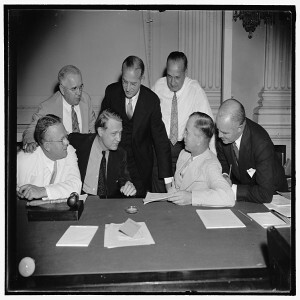

”Communists!” “Reds!” Long have these been the cries of the press and politicians seeking to undermine the labor movement in the United States.
But sometimes even labor leaders themselves got caught up in the anti-Communist hysteria.
On this day in Labor History the year was 1938.
President of the Metal Trades Department of the American Federation of Labor, John P. Frey, gave testimony before the Special Committee on Un-American Activities.
It was also known as the “Dies Committee.”
Texas Congressman Martin Dies, Jr. founded the effort to root out an alleged Communist threat in the U.S.
In his testimony Frey alleged three hundred leaders of the Congress of Industrial Organization were Communists.
At the time the AFL and CIO were two separate organizations.
The CIO had split off from the AFL to pursue more organizing in industries like auto making and steel.
Even after his testimony, Frey maintained a network of operatives in the labor movement to identify suspected communists.
A few days after Frey spoke before Congress, the Chicago Tribune ran a story explaining the perceived communist-labor threat.
The article declared, “If the communists in the United States continued to operate as the communist party they would have no influence on American foreign policy in the foreseeable future. But by making themselves leaders of labor and therefore powerful in Democratic counsels they can be of immediate value to the soviets.”
The paper warned that the communists were hoping to march the US into another European war.
War-weary after World War I, the public had little appetite for another major conflict.
The charge that the CIO was infiltrated by communists who wanted war took its toll on the radical labor organization, dividing workers by playing into the fears and hysteria of the era.
More Episodes
All Episodes>>You may also like
Create Your Podcast In Minutes
- Full-featured podcast site
- Unlimited storage and bandwidth
- Comprehensive podcast stats
- Distribute to Apple Podcasts, Spotify, and more
- Make money with your podcast











